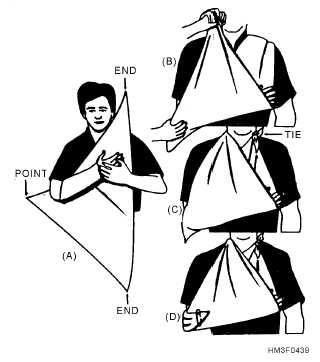Rib Fracture
If a rib is broken, make the victim comfortable and
quiet so that the greatest dangerthe possibility of
further damage to the lungs, heart, or chest wall by the
broken endsis minimized.
The common finding in all victims with fractured
ribs is pain localized at the site of the fracture. By
asking the patient to point out the exact area of the pain,
you can often determine the location of the injury.
There may or may not be a rib deformity, chest wall
contusion, or laceration of the area. Deep breathing,
coughing, or movement is usually painful. The patient
generally wishes to remain still and may often lean
toward the injured side, with a hand over the fractured
area to immobilize the chest and to ease the pain.
Ordinarily, rib fractures are not bound, strapped,
or taped if the victim is reasonably comfortable.
However, they may be splinted by the use of external
support.
If the patient is considerably more
comfortable with the chest immobilized, the best
method is to use a swathe (fig. 4-40) in which the arm
on the injured side is strapped to the chest to limit
motion. Place the arm on the injured side against the
chest, with the palm flat, thumb up, and the forearm
raised to a 45 angle. Immobilize the chest, using wide
strips of bandage to secure the arm to the chest.
Do not use wide strips of adhesive plaster applied
directly to the skin of the chest for immobilization
since the adhesive tends to limit the ability of the chest
to expand (interfering with proper breathing). Treat
the victim for shock and evacuate as soon as possible.
Nose Fracture
A fracture of the nose usually causes localized pain
and swelling, a noticeable deformity of the nose, and
extensive nosebleed.
Stop the nosebleed. Have the victim sit quietly,
with the head tipped slightly backward. Tell the victim
to breathe through the mouth and not to blow the nose.
If the bleeding does not stop within a few minutes,
apply a cold compress or an ice bag over the nose.
Treat the victim for shock.
Ensure the victim
receives a medical officer’s attention as soon as
possible. Permanent deformity of the nose may result
if the fracture is not treated promptly.
Jaw Fracture
A person who has a fractured jaw may suffer
serious interference with breathing. There is likely to
be great difficulty in talking, chewing, or swallowing.
Any movement of the jaw causes pain. The teeth may
be out of line, and there may be bleeding from the
gums. Considerable swelling may develop.
4-50
Figure 4-39.—Sling for immobilizing fractured clavicle.
Figure 4-40.—Swathe bandage of fractured rib victim.



